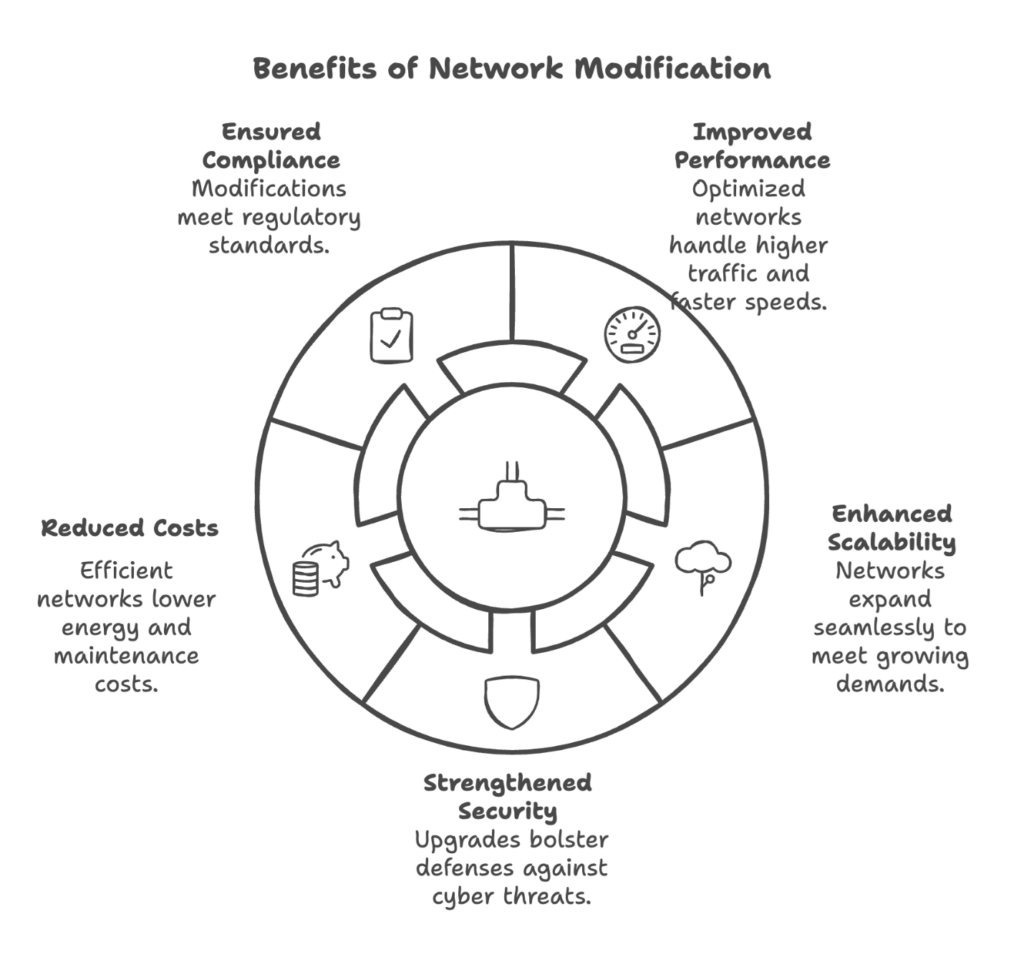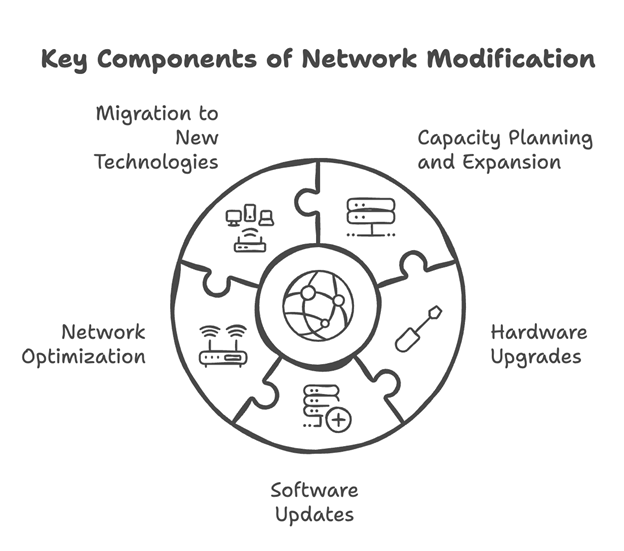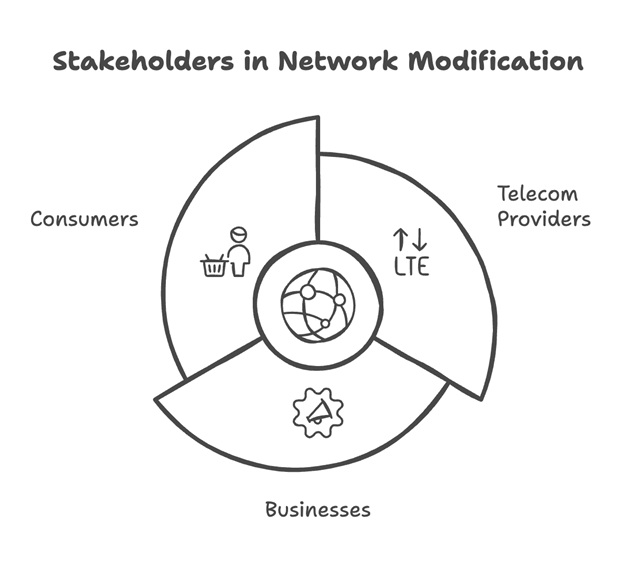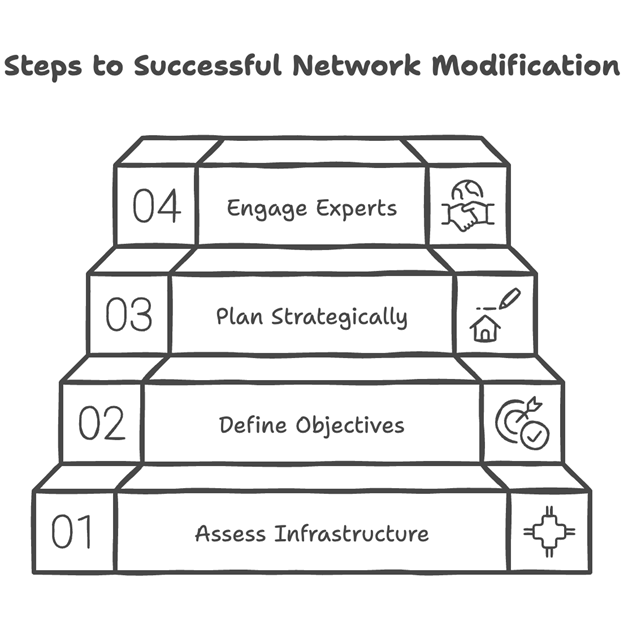Introduction to Network Modification
What is Network Modification?
Network modification refers to the process of making strategic changes to existing telecommunications networks to enhance their performance, scalability, and efficiency. These modifications can range from upgrading outdated hardware and software to reconfiguring network architecture or integrating new technologies like 5G and IoT. By adapting to changing demands, network modification ensures that telecom infrastructure remains robust, secure, and capable of supporting modern connectivity requirements.
This page provides a foundational understanding of network modification. For a deeper dive into specific strategies and benefits, visit our Comprehensive Guide to Network Modification.
Example Use Case: Addressing Bottlenecks in High-Traffic Networks
Imagine a telecom provider experiencing frequent service disruptions during peak hours. By implementing network optimization strategies, such as rerouting data traffic and upgrading key hardware, the provider reduces downtime and improves customer satisfaction. This is just one scenario where network modification proves invaluable.
Why is Network Modification Important?
The telecommunications landscape is constantly evolving, driven by rapid technological advancements and growing user demands. Network modification plays a vital role in keeping pace with these changes by:
- Improving Performance: Optimized networks can handle higher traffic volumes, provide faster speeds, and ensure consistent connectivity.
- Enhancing Scalability: Modifications allow networks to expand seamlessly, accommodating increased user demands and emerging technologies.
- Strengthening Security: Upgrades and adjustments help address vulnerabilities and bolster defenses against cyber threats.
- Reducing Costs: Efficient networks consume less energy and require fewer resources for maintenance and operation.
- Ensuring Compliance: Modifications often address regulatory requirements, ensuring networks meet industry standards.


Key Areas of Network Modification
- Capacity Planning and Expansion: Ensures networks can scale to meet growing demands through resource allocation and infrastructure enhancements. For example, adding extra bandwidth to prevent congestion during high usage periods.
- Hardware Upgrades: Replacing legacy systems with modern equipment improves performance, energy efficiency, and compatibility with new technologies. For instance, upgrading routers to support higher data speeds is a common practice.
- Software Updates: Regular updates enhance functionality, address security vulnerabilities, and support integration with advanced devices and services. Automated update tools can streamline this process, ensuring consistency across the network.
- Network Optimization: Reconfiguring network architecture and reallocating resources eliminates bottlenecks and improves overall efficiency. Techniques like traffic shaping and dynamic resource allocation are often employed.
- Migration to New Technologies: Transitioning to innovative solutions like 5G infrastructure ensures networks remain competitive and capable of supporting advanced applications. Migrating to cloud-based architectures is another trend gaining traction in telecom.
For a detailed exploration of these key areas, check out our Comprehensive Guide to Network Modification.
Who Benefits from Network Modification?
Network modification is beneficial for a wide range of stakeholders, including:
- Telecom Providers: Enhanced infrastructure improves service quality and operational efficiency. For example, streamlined operations can reduce time-to-market for new services.
- Businesses: Reliable and scalable networks support productivity and digital transformation initiatives, such as adopting IoT-enabled solutions.
- Consumers: Faster, more reliable connections enhance user experiences across devices and platforms. This is especially important in an era of remote work and high-bandwidth applications.


How to Get Started
To embark on a network modification project, it is essential to:
- Assess Current Infrastructure: Identify weaknesses and areas for improvement through a detailed evaluation. Tools like network performance analyzers can help pinpoint bottlenecks.
- Define Objectives: Set clear goals for the modification project, aligned with organizational needs and market demands. For instance, reducing latency for video conferencing platforms might be a key objective.
- Plan Strategically: Develop a roadmap for implementation, considering budget, resources, and potential risks. Risk mitigation plans should address potential downtime during upgrades.
- Engage Experts: Work with skilled professionals to ensure smooth execution and successful outcomes. Collaboration with industry consultants or managed service providers can provide valuable insights.
FAQ Section
How often should a network be modified?
This depends on usage patterns and technological advancements. However, most telecom providers review their infrastructure every 2-3 years.
What are the first signs that a network needs modification?
Common indicators include increased downtime, slower speeds, and an inability to support new devices or applications.
Network modification is a transformative process that positions telecom providers and businesses for future growth. By embracing change and investing in strategic upgrades, stakeholders can stay ahead in an increasingly connected world.
What is the cost of network modification?
The cost of network modification varies depending on the scope of the project, including hardware, software, labor, and downtime considerations. Many organizations conduct a cost-benefit analysis before beginning modifications.
What tools are essential for successful network modification?
Popular tools include network performance analyzers, traffic monitoring software, and automated configuration tools. These technologies ensure accuracy and efficiency during the modification process.
How does 5G affect network modification strategies?
5G introduces higher bandwidth and lower latency requirements, necessitating upgrades in both hardware and network architecture. Transitioning to 5G often involves substantial reconfigurations and investments.
Network modification is a transformative process that positions telecom providers and businesses for future growth. By embracing change and investing in strategic upgrades, stakeholders can stay ahead in an increasingly connected world.
For in-depth insights and advanced strategies, visit our Comprehensive Guide to Network Modification.

